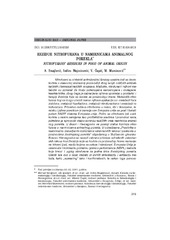Приказ основних података о документу
Nitrofurans' residues in food of animal origin
Rezidue nitrofurana u namirnicama animalnog porekla
| dc.creator | Smajlović, Ahmed | |
| dc.creator | Mujezinović, Indira | |
| dc.creator | Ćupić, Vitomir | |
| dc.creator | Muminović, Mehmed | |
| dc.date.accessioned | 2020-06-03T13:29:03Z | |
| dc.date.available | 2020-06-03T13:29:03Z | |
| dc.date.issued | 2011 | |
| dc.identifier.issn | 0350-2457 | |
| dc.identifier.uri | https://vet-erinar.vet.bg.ac.rs/handle/123456789/817 | |
| dc.description.abstract | Nitrofurans are synthetic broad-spectrum antimicobial agents that are often used in commercial animal production because of their excellent antibacterial and pharmacokinetic properties. However, nitrofurans and their metabolites have been shown to have potentially carcinogenic and mutagenic characteristics which has led to a ban on the use of nitrofurans in preventive and therapeutic treatment of animals used for food production. Metabolites of nitrofurans that can be determined after their application are: a metabolite of furazolidone, furaltadone metabolite, a metabolite of nitrofurantoin and nitrofurazone metabolite. The presence of residues of nitrofuran antibiotics in meat, fish and shrimps, and milk and eggs originating from countries outside the European Union is monitored and recorded by the RASFF system of the European Union. Furthermore, since nitrofurans are used in some countries as prophylactic agents and growth promoters, it is necessary to carry out constant control of various types of food of animal origin, in order to reduce to the minimum potential carcinogenic and mutagenic effects of these supstances for the health of consumers. In Bosnia and Herzegovina, there is no permanent control of nitrofurans in food of animal origin. The provisions of the 'Regulation on the maximum allowable amounts of veterinary drugs and pesticides in products of animal origin', published in the Official Gazette of Bosnia and Herzegovina state the prohibiting of the use of certain veterinary drugs in animals intended for human consumption, including nitrofurans. The European Union has established the minimum required limit (MRLP) for performance which is 1 μg/kg of nitrofurans for edible tissues of animal origin. Taking all this into account, methods for nitrofurans detection should be accreditated and validated, both for screening and confirmatory methods, and further research into the presence of nitrofurans in food of animal origin in Bosnia and Herzegovina should be performed. | en |
| dc.description.abstract | Nitrofurani su sintetski antimikrobici širokog spektra koji se često koriste u masovnoj animalnoj proizvodnji zbog svojih odličnih antibakterijskih i farmakokinetičkih svojstava. Međutim, nitrofurani i njihovi metaboliti su pokazali da imaju potencijalne kancerogene i mutagene karakteristike, zbog čega je zabranjena njihova upotreba u profilaksi i terapiji životinja koje se koriste za proizvodnju hrane. Metaboliti nitrofurana koji se mogu utvrditi nakon njihove aplikacije su: metabolit furazolidona, metabolit furaltadona, metabolit nitrofurantoina i metabolit nitrofurazona. Prisustvo rezidua nitrofurana u mesu, ribi i škampima, te mleku i jajima poreklom iz zemalja van Evropske unije se prati i beleži putem RASFF sistema Evropske unije. Pošto se nitrofurani još uvek koriste u nekim zemljama kao profilaktička sredstva i promotori rasta, potrebno je sprovoditi stalnu kontrolu različitih vrsta namirnica animalnog porekla. U Bosni i Hercegovini ne postoji stalna kontrola nitrofurana u namirnicama animalnog porekla. U odredbama 'Pravilnika o maksimalno dozvoljenim količinama veterinarskih lekova i pesticida u proizvodima životinjskog porekla' objavljenog u Službenom glasniku Bosne i Hercegovine se navodi zabrana primene određenih veterinarskih lekova kod životinja koje se koriste za proizvodnju hrane namenjene ishrani ljudi, među kojima se nalaze i nitrofurani. Evropska Unija je ustanovila i minimalnu potrebnu granicu performance (MRPL) metoda koja iznosi 1 μg/kg nitrofurana za jestiva tkiva životinjskog porekla. Uzevši sve ovo u obzir, trebalo bi izvršiti akreditaciju i validaciju metoda, kako 'screening' tako i konfirmativnih, te nakon toga ponovo sprovesti daljnja istraživanja prisustva nitrofurana u namirnicama animalnog porekla u Bosni i Hercegovini. | sr |
| dc.publisher | Univerzitet u Beogradu - Fakultet veterinarske medicine, Beograd | |
| dc.rights | openAccess | |
| dc.rights.uri | https://creativecommons.org/licenses/by/4.0/ | |
| dc.source | Veterinarski Glasnik | |
| dc.subject | nitrofurans | en |
| dc.subject | RASFF system | en |
| dc.subject | MRPL | en |
| dc.subject | screening and confirmative methods | en |
| dc.subject | MRPL | sr |
| dc.subject | nitrofurani | sr |
| dc.subject | RASFF sistem | sr |
| dc.subject | screening i konfirmativne metode | sr |
| dc.title | Nitrofurans' residues in food of animal origin | en |
| dc.title | Rezidue nitrofurana u namirnicama animalnog porekla | sr |
| dc.type | article | |
| dc.rights.license | BY | |
| dcterms.abstract | Ћупић, Витомир; Смајловић, Aхмед; Мујезиновић, Индира; Муминовић, Мехмед; Резидуе нитрофурана у намирницама анималног порекла; Резидуе нитрофурана у намирницама анималног порекла; | |
| dc.citation.volume | 65 | |
| dc.citation.issue | 3-4 | |
| dc.citation.spage | 215 | |
| dc.citation.epage | 222 | |
| dc.citation.other | 65(3-4): 215-222 | |
| dc.citation.rank | M24 | |
| dc.identifier.doi | 10.2298/VETGL1104215S | |
| dc.identifier.fulltext | https://vet-erinar.vet.bg.ac.rs/bitstream/id/1350/816.pdf | |
| dc.type.version | publishedVersion |

